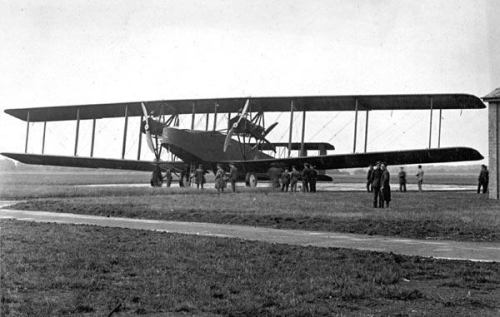
The The Handley Page V/1500, which first entered service in 1918, was the first British bomber with four engines. It was known within the fledging RAF as the ‘Super Handley’. Two squadrons were formed at Bircham Newton (No. 166 Squadron and No. 167 Squadron) with the express purpose of bombing Berlin.
The short answer is no. As to why, that requires a very long answer. Briefly, 27 Group RAF based at Bircham Newton in Norfolk was Trenchard’s chosen instrument for raiding Berlin. It was commanded by a Canadian, Col. R.H. Mulock, which was to be equipped with the Handley Page V1500 bombers (the British answer to the German Giants). The RAF planning staff projected a round trip from this base of 1000 miles; the V1500 was supposed to have an endurance of 14 hours cruising at 100 mph, and with a bomb load of about 2 tons. The V1500 had four Rolls Royce Eagle VIII engines of 375 hp each.
Allied plans for 1919 would have bombing Berlin with the Handley-Page V.1500. The RAF had plans in motion to have a 200 Squadron bombing force (Independent Force) by July 1919. The pieces were coming together at war’s end, but I doubt that the date would have been met. Think of the logistics to support this force. The HP V1500 were going to bomb Berlin from bases in Scotland!
The RAF had started on the Berlin project much too late: not until 29 August 1918 was 27 Group formed, with two wings, Nos. 86 and 87. Crewing up these giants, and conducting specialized training, occupied September and early October, when the first flight testing of the V1500 took place. After some favourable results, Mulock was put to the question by Trenchard:
“Urgent your definite views as to whether the V 1500 can do the long trip … and if so the earliest it can be used.” To which Mulock replied, “Yes, it is possible under favourable weather with the figures we have at present” (This was shortly after 15 October). Trenchard responded: “I give you freedom to carry out this operation on the lines you propose when you consider you are ready”
Three V1500 were delivered to No. 166 Squadron at RAF Bircham Newton (Norfolk) during October 1918. The squadron commander did not get clear orders for his mission until November 8 due to the above debate at high level. A mission was scheduled for that night (bomb Berlin, fly on to Prague as the Austro-Hungarian forces had surrendered by then, refuel, re-arm, bomb Düsseldorf on the way back). No mission was flown – a technical expert insisted that all the engines on one aircraft be changed. The same happened the following day (but with a different aircraft). The three aircraft were about to taxi out after the second set of engine changes when an excited ground crew member ran out to stop them — the Armistice had just been declared.
So this heavy bomber was never used against Berlin, or against any other target. We do know that later on Armistice Day, one of the V1500s flew over London with ‘forty-one on board–ten girls and thirty-one men.’”